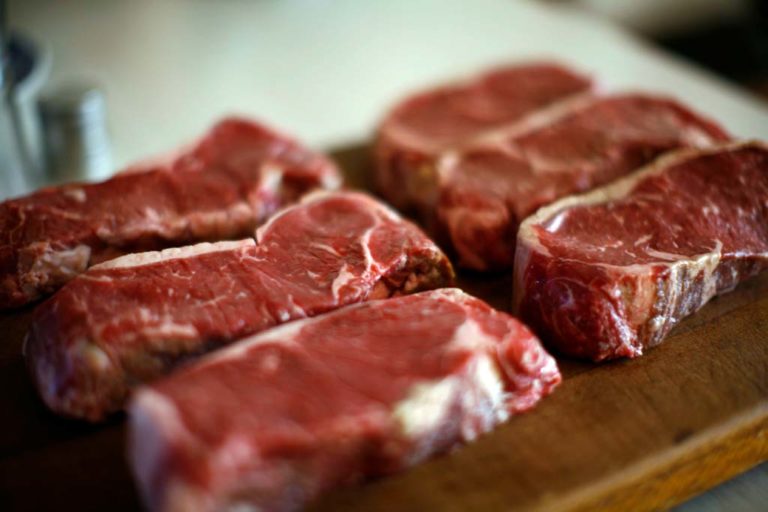
Chef's notes:
The New York strip and Kansas City strip are tender cuts of meat that come from the strip loin portion of the beef cow. It is very close in proximity to the tenderloin; just a thin bone separates them. When both are served on the bone, it is know as a T-bone or porterhouse depending on the size. The New York strip is a boneless slice of strip loin with no tenderloin. The Kansas City strip is generally on the bone but still without any tenderloin. The steaks I used for this article were New York strips. Because this meat is so tender and flavorful, I would recommend keeping the spices simple. Save your marinades for cheaper steaks that need a little tenderizing.
Ingredients
- 6 New York strips
- Sea salt
- Black pepper
- Vegetable oil
- Butter (optional)
Grilled New York Strip Steak: Seasoned with Sea Salt and Black Pepper
- Steak should always be cooked from near room temperature. So take the meat out of the fridge a full hour before you cook it. Prep the meat with a bit of sea salt and black pepper and a bit of vegetable oil, rubbed in by hand. The vegetable oil helps keep the meat from sticking, and it also facilitates the caramelizing process known as the Maillard reaction. Begin heating up the grill at least 20 minutes before you put the meat on. Turn the burners on high and scrape any nasty bits off the grates.
- Once the grill is up to heat, put the steaks on the grill slightly perpendicular to the direction of the grate. Give them a little room in between so the sides can cook. After the steaks have been cooking for 4 to 5 minutes, rotate them about 20 degrees so they are slightly perpendicular on the other side of the grates. This will give the steaks nice diamond shaped grill marks. Remember it is a slight rotation of 20–30 degrees. If you rotate too much, the steaks will have square grill marks.
- After finishing the first side, flip the steak over and do the same thing to the second side. If the steak is getting close to being done, you don’t have to cook it as long on the second side. The pink center will just be a little skewed to one side. Next time, you know to cook it less on the first side. How long you leave your steak on the grill will depend on how you like your steak. I cooked these steaks on high heat to medium rare in a total of 10–12 minutes, around 6 minutes per side. Keep checking your meat as it cooks to get a feel for the way it changes as it cooks. Knowing how a medium rare steak feels to touch is the best way to judge done-ness.
- Once the steaks are done to your liking, remove them from the grill. The next and final step before eating them is letting them rest. The reason you let meat rest before you eat is is because the inside of the meat is bubbly, and the juices are moving around a lot. Letting it sit for 10 minutes allows these juices to cool and coagulate. If you cut into an unrested steak, the juices will run out leaving the steak dry. To rest steak, put it on a grated rack to allow the juices a place to run, and cover it loosely with aluminum foil. Yes, some juices will come out, but don’t worry—it won’t be too much. If you want a special treat, top the resting steaks with a knob of butter. It is quite tasty.
Tips & Tricks
- Not all grills are created equal. Old grills have a tendency to have both hot and cold spots. Cold spots are a result of places where gas is not burned, probably because the holes are clogged or there is not enough oxygen available. Of course this blocked gas finds it way out another location, which makes a hot spot. To anyone who has tried to grill on one of these grills, you know how frustrating unreliable equipment can be. This is of course a problem only encountered with gas grills.
- Charcoal grills take a bit more work to get started, but once going, they are easy to monitor and easy to keep going. I used to put charcoal briquettes into my Dad’s gas grill and use the gas to get the briquettes burning and then turn the gas off. I thought I was a freakin’ genius. But I doubt I am the first person to try that. Either way, if you keep your grill clean and out of the elements, your problems will be greatly reduced.
